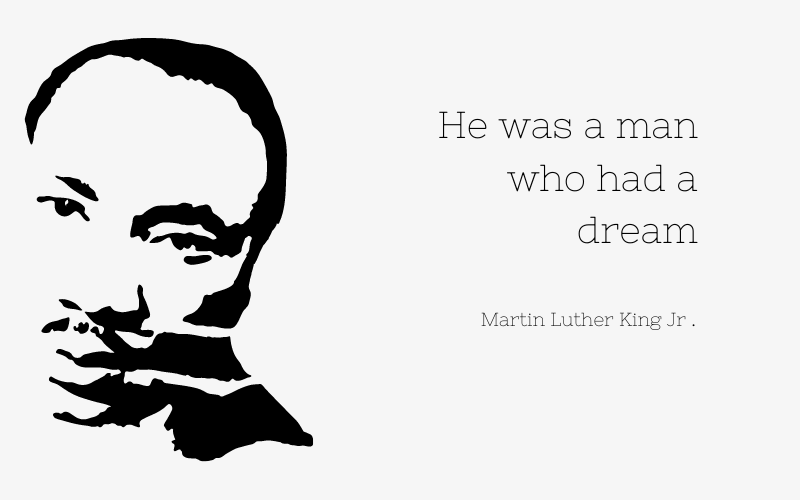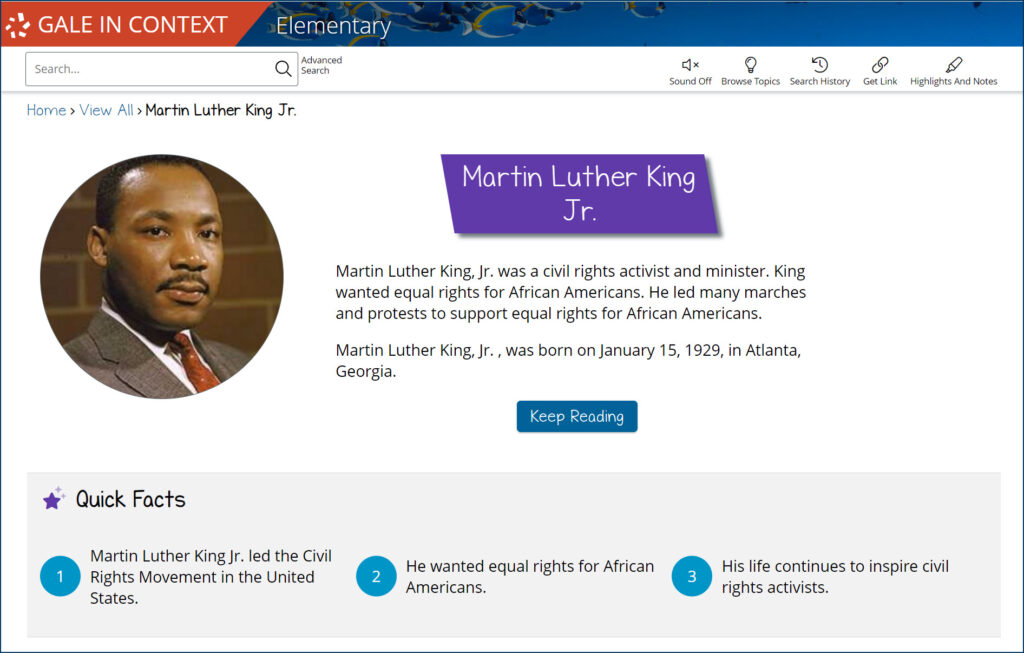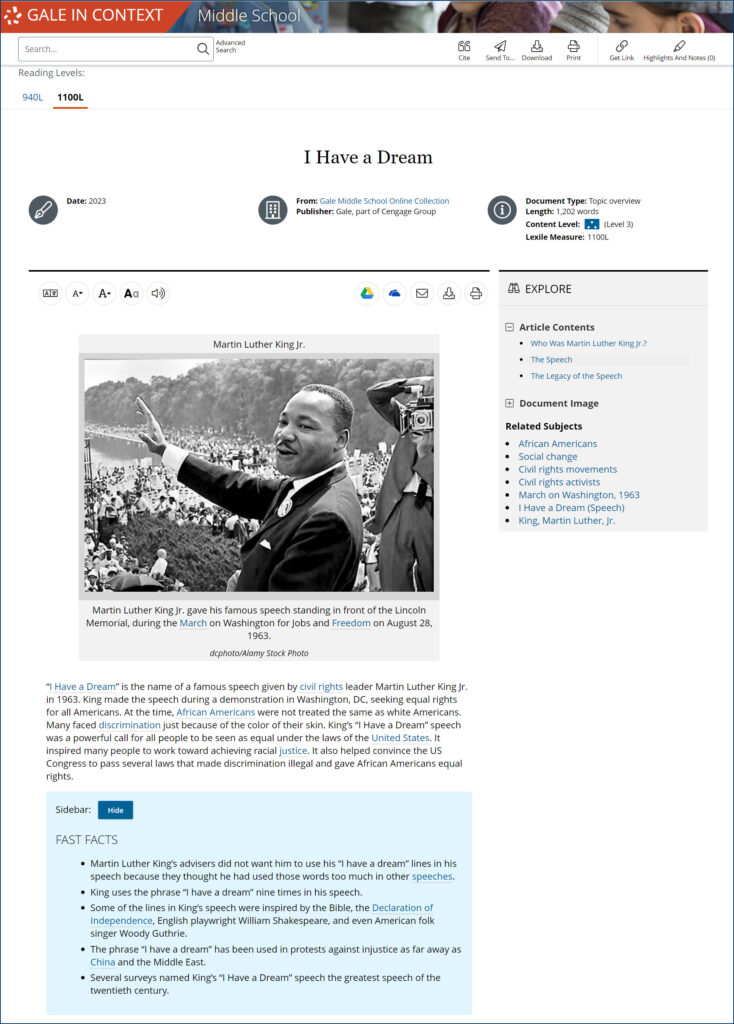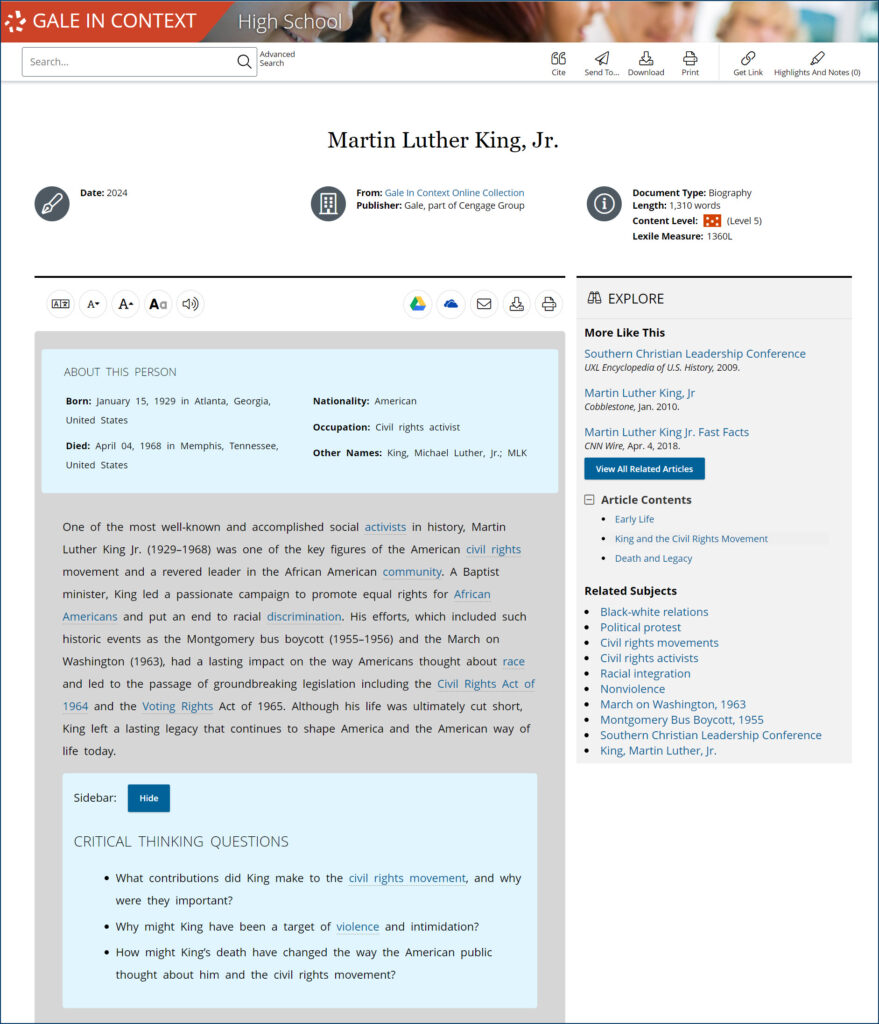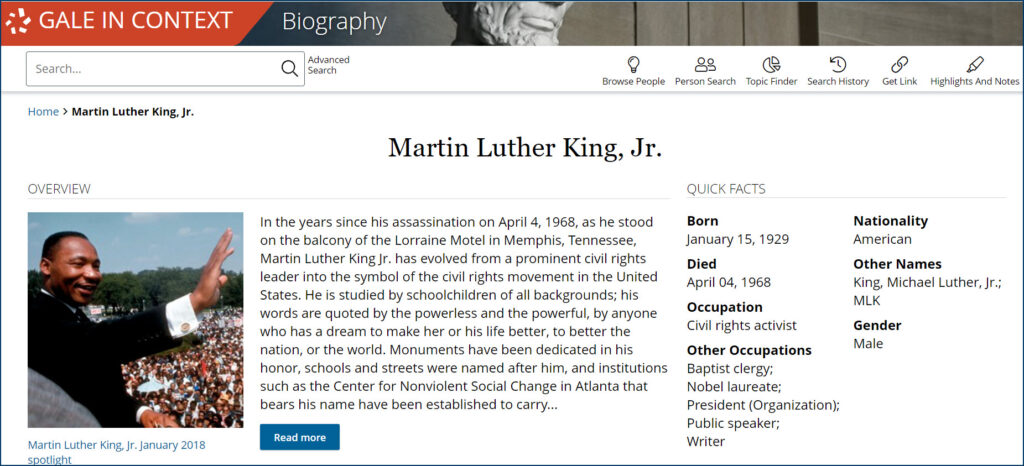| By Gale Staff |
On October 14, 1964, Martin Luther King, Jr., achieved a historic milestone at the age of 35, becoming the youngest person to ever receive the Nobel Peace Prize. The milestone stood until 2011 when the Yemeni human rights activist Tawakkol Karman won the prize at the age of 32.
In his acceptance speech, King alluded to the ongoing struggles of the U.S. Civil Rights Movement. Although President Lyndon B. Johnson had signed the Civil Rights Act of 1964 earlier that year, the U.S. was still grappling with segregation and violence against African Americans. The Nobel Peace Prize was a testament to King’s resilience and determination, recognizing his commitment to nonviolence and his unwavering support for racial justice on a global stage.
This October marks 60 years since King’s Nobel Peace Prize. K-12 educators can highlight that pivotal moment and inspire their students to delve deeper into King’s life and work. We’ll show you how to explore related resources across several Gale databases, leveraging high-impact content to enrich classroom discussion and learning.
Introduce Elementary Students to King
King was instrumental in expanding equal rights for our country, all in the name of his dream for a more just and fair society. Introduce the concepts of equality and legacy to your elementary students. What were King’s goals? What did he accomplish?
The complexities of King’s life and the Civil Rights Movement can be challenging to teach at the elementary level. To address this, instructors can rely on Gale In Context: Elementary, which provides a wealth of age-appropriate materials to facilitate learning.
Our custom platform includes a Martin Luther King, Jr. portal that features an easy-to-read biographical summary, fast facts, helpful graphics, news articles, and countless other resources curated for young learners. Guide students to Gale’s comprehensive summary page on the Civil Rights Movement and leverage helpful tools, including the built-in vocabulary assistance and main ideas. Users can also toggle the reading levels for age and ability.
Take Research a Step Further in Middle School
As your students grow, they can handle increasingly complicated topics and engage with more challenging research materials. Gale in Context: Middle School serves as an academic bridge between the simplified elementary database and the more advanced content they will encounter in high school. Start with the approachable King summary page—notice you can still adjust for reading level—and dig into critical concepts such as civil disobedience and social activism.
As a class, listen to King’s iconic “I Have a Dream” speech, an oration that continue to inspire people worldwide to work together toward racial equality. Encourage students to consider how the speech resonates with them, recognizing how powerful words and symbols can inspire change.
From there, students can further explore King’s prominence as a civil rights leader. Using the Martin Luther King, Jr. portal in Gale in Context: Middle School, learn more about the 1963 March on Washington, the Montgomery bus boycott, and his “Letter from Birmingham Jail.”
Encourage High Schoolers to Make Modern Connections
Today, the country honors King’s work through dedicated service events every third Monday in January and his teachings continue to influence socially motivated protests. Your high school students have the skills to make connections between the past and the present, identifying how King’s legacy endures. Gale in Context: High School can help prepare them for in-depth study, introducing more complex resources to challenge their preconceptions.
Begin with Gale’s Martin Luther King, Jr. topic page for high school students, which provides thoughtful prompts designed to initiate more engaged reading. For example, why was King the target of violence throughout his life? How did his assassination impact the American people? Through academic essays and other advanced materials, discover connections between prominent black American leaders and King’s work. Encourage students to identify how modern civil rights issues, such as Black Lives Matter, parallel or differ from King’s teachings.
Integrate Biography
Biography is a powerful tool to help students understand the people behind major historical events and movements. Students across all grade levels can use Gale In Context: Biography to gain a more in-depth perspective on King’s life before he became a global symbol for civil rights.
Born in Atlanta, Georgia, King was raised in a middle-class Baptist household. Intelligent and inquisitive, he was a stand-out student and, at 19 years old, attended the Crozer Theological Seminary to study philosophy and ethics. Around this time, he learned of Mahatma Gandhi’s nonviolent teachings, which informed his civil rights activism for the rest of his life.
After graduating, King had many potential career paths, but he chose to start his own church in the deeply segregated Montgomery, Alabama. Through his work as pastor, he fostered a socially minded and politically active congregation and quickly, if not somewhat unintentionally, became a leader of the budding Civil Rights Movement. With your class, discuss the man behind the movement: pastor, teacher, father, protestor—and black man living in the highly antagonistic Jim Crow South.
Consider the Historical Context of His Accomplishments
Using Gale In Context: U.S. History, your students can learn more about the historical time period in which King lived and why the U.S. was primed for change by the mid-20th century. During the Reconstruction Period, black people sought leadership positions and pursued equal rights initiatives. However, many resisted these changes, implementing Jim Crow laws throughout the Deep South that enforced racial discrimination in public life.
Despite these ongoing injustices, African Americans fought bravely in World War II, with many black soldiers receiving military honors. Their admirable service shed an ugly light on the discrimination they faced from their white comrades. At home, black Americans stepped up to fill vital manufacturing jobs and support the wartime effort; these workers gained new skills, and their social standing rose accordingly. Thus, World War II helped catalyze the Civil Rights Movement.
Then in 1955, Rosa Parks refused to change her seat on a public bus, sparking the Montgomery bus boycott. The event helped push local Montgomery pastor Martin Luther King, Jr., onto the national stage. King became a leader—and a target of racial violence, wire-tapping, and, ultimately, assassination. Having the full historical picture in mind helps contextualize King’s tremendous legacy and accolades, including the Nobel Peace Prize.
With your Gale subscription, there are countless ways to embark on your MLK-themed research. Gale collections work across grades and disciplines, providing a diverse library of digital materials and diverse perspectives. If your institution is not a member of our network, contact your local Gale representative today.

